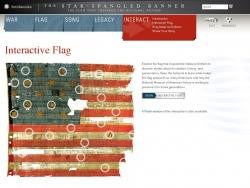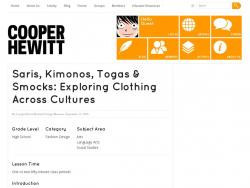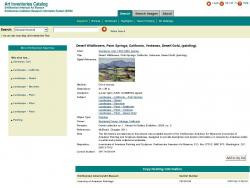Kate Harris
Social Studies teacher
Pittsburgh CAPA
Middle School (13 to 15 years old), High School (16 to 18 years old)
Teacher/Educator
Language Arts And English, Civics, Literature, Cultures, Economics, Social Studies, Geography, Writing, US History, Arts, Other
I'm a history-lover, art fan, and bookworm. I taught high school history (U.S. History and World Religions) for ten years in North Carolina, teach currently in Pittsburgh, PA, and am working to help teachers make the most of this new resource!
Kate Harris's collections
Exploring American Ideals in Art
<p>How can American ideals be defined and expressed in different ways? The United States of America is associated the ideals of Democracy, Rights, Liberty, Opportunity, and Equality. Those values have served as sources of inspiration for artists as goals that the nation aspires to (even if they are not always achieved). This collection contains artworks inspired by one or more of the ideals listed above. Students should choose a work and identify which ideal it relates to: Democracy, Rights, Liberty, Opportunity, and Equality. </p><p>In a short essay based on the artwork, students should answer the following questions:</p><p>-How would the student define Democracy, Rights, Liberty, Opportunity, or Equality?</p><p>-What is the artist trying to communicate about how this idea plays out in America?</p><p>-Does the student agree or disagree with the artist's interpretation?</p><p>If desired, students could create their own artwork based on one of the American ideals.</p>
 Kate Harris
Kate Harris
21
Examining Icebergs
<p>What can we learn about global climate change by examining icebergs? This teaching collection provides resources to support a lesson on climate change and polar ice melt. It includes a video, link to a lesson plan and photo essay from the Global Oneness Project, images, and a Smithsonian article. </p><p>tags: climate change, global warming, iceberg, glacier, melt, temperature, environment</p>
 Kate Harris
Kate Harris
6
Evolution of an Artist: William H. Johnson
<p>The clippings, paintings, and other items here will all help you develop an understanding of William H. Johnson's life and growth as an artist. First, read the biography in the first resource. Then, try to order the remaining collection items from earliest to latest, using clues from the informational text and the style and subject of each work. Once finished, review the progression you have created. How would you describe the evolution of Johnson's art? Can you connect changes in his art to world or personal events?</p><p>tags: Harlem, Federal Art Project, sorting, folk art, African-American, painter</p>
 Kate Harris
Kate Harris
31
Earl Hines: An Innovative Jazz Musician
<p>Earl Hines embodies the innovator mindset because he was experimental, collaborative, resilient and resourceful. He invented a new style of playing the piano and became well-known for his work with other jazz musicians. As you look through this collection, try to find more examples of his innovator mindset. </p><p>For more on the characteristics that make up an innovator, look at the Heinz History Center website. You can even take a quiz and find out what innovator you are most like:</p><p><a href="http://www.heinzhistorycenter.org/education/school-programs-k-12/steam/innovator-match-up">http://www.heinzhistorycenter.org/education/school...</a></p><p>tags: Pittsburgh, Chicago, jazz, segregation, music</p>
 Kate Harris
Kate Harris
16
Dulce et Decorum Est--Poetry from World War I
<p>Why are artists' representations of war important? This student activity uses a poem by Wilfred Owen, "Dulce et Decorum Est," and several images to encourage reflection on soldiers' experiences and views of war. Students will explore the descriptive language and artistic choices made to determine what emotions are evoked by the art and what attitudes towards war are represented. Finally, students will be asked to consider and write about their own beliefs regarding war.</p>
 Kate Harris
Kate Harris
9
3D Technology and Repatriation of the Kéet-S’aaxw
<p>This student activity introduces students to the concept of repatriation of cultural heritage items to the tribes to whom they belong, and the ways that museums and Native American groups are now using 3D technology to aid in the process. A killer whale hat, or kéet-s'aaxw, was requested to be repatriated by members of the Tlingit tribe. The Smithsonian Institution, under the repatriation provisions of the National Museum of the American Indian Act, did so. In the years following, the clan's leader decided that it might be beneficial to 3D scan the image in order to preserve its details and protect it in case of loss or fire. Having this data allowed the museum to create an accurate replica to be used for educational purposes, and provided the tribe with peace of mind. Learn more about this story and other cases of repatriation and replication in this collection which includes a 3D model and tour, video, website, and images of objects that have been part of the process. </p>
<p>Essential Questions include:</p>
<ul><li>How does the current process of repatriation reflect a change in traditional relationships between museums and indigenous groups?</li><li>What kinds of guidelines should be used to determine which objects should be repatriated?</li><li>What benefits does 3D technology provide for museums and Native American tribes? Can you envision other scenarios where 3D technology might play a similarly beneficial role?</li></ul><p>Tags: Native American, American Indian, Tlingit, repatriation, replication, 3D technology, whale hat, indigenous, rights, change over time, museums, anthropology</p>
 Kate Harris
Kate Harris
10
Dogs in History
An ongoing, and mostly for fun, collection representing how our furry friends have been appreciated throughout history.
 Kate Harris
Kate Harris
23
Discover the Story: A Miner's Life
This collection includes objects and artifacts representing life in as a miner. Students are challenged to write a creative story or narrative based on the objects in the collection, illustrating life at the time. The last two resources in the collection are a worksheet that teachers may use to frame the assignment and a grading rubric for the assignment.
Tags: Pennsylvania, narrative, Pittsburgh, mining, miner, immigration, coal, worker safety, child labor
 Kate Harris
Kate Harris
16
Context for Weikers Family Collection: Life in Nazi Germany and Resettling in the United States
<p>This collection was created to align with with the Weikers Family collection and provides general context about life in Germany for a Jewish family in the 1930s and their eventual resettlement to the United States. The artifacts in the collection are not necessarily specific to the Weikers family, but give some idea of how others might have shared similar experiences. </p><p>Tags: Nazi Germany, Holocaust era, primary sources, Pittsburgh</p>
 Kate Harris
Kate Harris
19
Clothing Across Cultures
This teaching collection was made to accompany the Cooper Hewitt Design Museum lesson plan "Saris, Kimonos, Togas & Smocks: Exploring Clothing Across Cultures." In addition to saris, kimonos, togas, and smocks, huipils and kanga are used as examples of culturally-specific clothing.
The lesson asks students to complete think about the cultural importance of clothing, and then to research a specific type of clothing and build a presentation around that research. Students might use this collection as a source for images for their presentation, to inspire research topics, or as a common basis for discussion with their peers.
 Kate Harris
Kate Harris
32
Claim-Support-Question: A Sharecropper's Shack
Using the Project Zero Visible Thinking routine "Claim Support Question," a routine for clarifying truth claims, students will examine a photograph taken by Carl Mydans for the Farm Security Administration. This exercise could be used as a warm up for a lesson about the Great Depression's impact on farmers, sharecropping, or the New Deal.
Tags: Roosevelt, New Deal, Farm Security Administration, Great Depression, tenant farmer, sharecropper, migrant farmer, Okie, Missouri, Oklahoma, Dust Bowl, Resettlement Administration.
 Kate Harris
Kate Harris
4
Civil Disobedience
<p>This is a topical collection on the concept of civil disobedience. Users are invited to explore the theme of civil disobedience through texts from Sophocles, Shelley, and Thoreau and a variety of images. </p><p>Questions to consider:</p><p>-Does civil disobedience pose a threat to society?</p><p>-What examples of civil disobedience are portrayed here? What are some other examples?</p><p>-What is the role of civil disobedience in today's society?</p><p>-Some people prefer the phrase "passive resistance" to "civil disobedience." Compare and contrast these two terms.</p><p>-How does one measure the success of an act of civil disobedience? Policy change? Public influence?</p><p>-What role does violence play in civil disobedience?</p><p>Tags: King, Gandhi, protest, Birmingham, Greensboro, suffrage, Boston Tea Party, Antigone, Masque of Anarchy, Tambo, nun, Randolph, civil rights, Mexican-American War, Goldman</p>
 Kate Harris
Kate Harris
17









